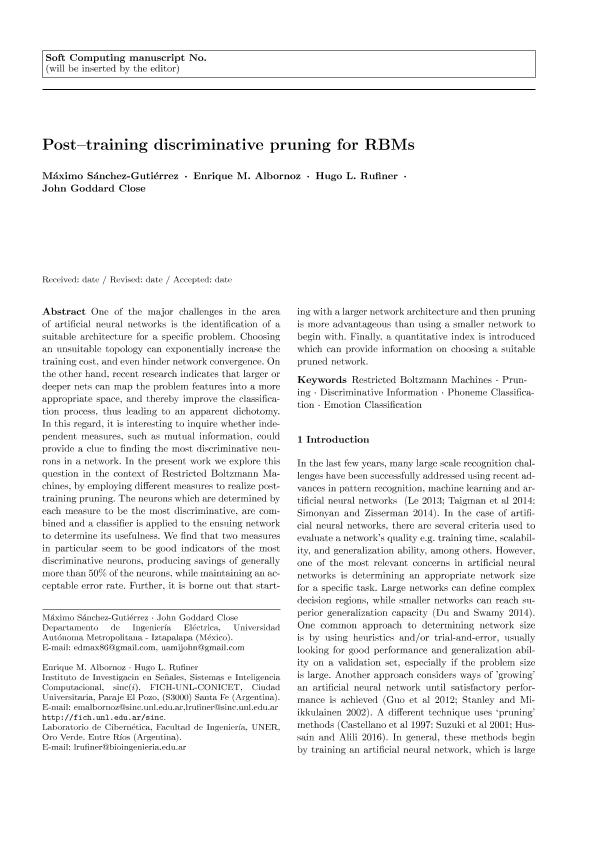Mostrar el registro sencillo del ítem
dc.contributor.author
Sánchez Gutiérrez, Máximo
dc.contributor.author
Albornoz, Enrique Marcelo

dc.contributor.author
Rufiner, Hugo Leonardo

dc.contributor.author
Close, John Goddard
dc.date.available
2018-06-01T19:52:10Z
dc.date.issued
2017-08
dc.identifier.citation
Sánchez Gutiérrez, Máximo; Albornoz, Enrique Marcelo; Rufiner, Hugo Leonardo; Close, John Goddard; Post-training discriminative pruning for RBMs; Springer; Soft Computing; 8-2017
dc.identifier.issn
1432-7643
dc.identifier.uri
http://hdl.handle.net/11336/47032
dc.description.abstract
One of the major challenges in the area of artificial neural networks is the identification of a suitable architecture for a specific problem. Choosing an unsuitable topology can exponentially increase the training cost, and even hinder network convergence. On the other hand, recent research indicates that larger or deeper nets can map the problem features into a more appropriate space, and thereby improve the classification process, thus leading to an apparent dichotomy. In this regard, it is interesting to inquire whether independent measures, such as mutual information, could provide a clue to finding the most discriminative neurons in a network. In the present work we explore this question in the context of Restricted Boltzmann Machines, by employing different measures to realize post-training pruning. The neurons which are determined by each measure to be the most discriminative, are combined and a classifier is applied to the ensuing network to determine its usefulness. We find that two measures in particular seem to be good indicators of the most discriminative neurons, producing savings of generally more than 50% of the neurons, while maintaining an acceptable error rate. Further, it is borne out that starting with a larger network architecture and then pruning is more advantageous than using a smaller network to begin with. Finally, a quantitative index is introduced which can provide information on choosing a suitable pruned network.
dc.format
application/pdf
dc.language.iso
eng
dc.publisher
Springer
dc.rights
info:eu-repo/semantics/openAccess
dc.rights.uri
https://creativecommons.org/licenses/by-nc-sa/2.5/ar/
dc.subject
Restricted Boltzmann Machines
dc.subject
Discriminative Information
dc.subject
Pruning
dc.subject
Emotion Classification
dc.subject
Phoneme Classification
dc.subject.classification
Ciencias de la Computación

dc.subject.classification
Ciencias de la Computación e Información

dc.subject.classification
CIENCIAS NATURALES Y EXACTAS

dc.title
Post-training discriminative pruning for RBMs
dc.type
info:eu-repo/semantics/article
dc.type
info:ar-repo/semantics/artículo
dc.type
info:eu-repo/semantics/publishedVersion
dc.date.updated
2018-05-31T18:18:57Z
dc.identifier.eissn
1433-7479
dc.journal.pais
Alemania

dc.journal.ciudad
Berlín
dc.description.fil
Fil: Sánchez Gutiérrez, Máximo. Universidad Autónoma Metropolitana; México
dc.description.fil
Fil: Albornoz, Enrique Marcelo. Consejo Nacional de Investigaciones Científicas y Técnicas. Centro Científico Tecnológico Conicet - Santa Fe. Instituto de Investigación en Señales, Sistemas e Inteligencia Computacional. Universidad Nacional del Litoral. Facultad de Ingeniería y Ciencias Hídricas. Instituto de Investigación en Señales, Sistemas e Inteligencia Computacional; Argentina
dc.description.fil
Fil: Rufiner, Hugo Leonardo. Consejo Nacional de Investigaciones Científicas y Técnicas. Centro Científico Tecnológico Conicet - Santa Fe. Instituto de Investigación en Señales, Sistemas e Inteligencia Computacional. Universidad Nacional del Litoral. Facultad de Ingeniería y Ciencias Hídricas. Instituto de Investigación en Señales, Sistemas e Inteligencia Computacional; Argentina. Universidad Nacional de Entre Ríos; Argentina
dc.description.fil
Fil: Close, John Goddard. Universidad Autónoma Metropolitana; México
dc.journal.title
Soft Computing
dc.relation.alternativeid
info:eu-repo/semantics/altIdentifier/url/http://link.springer.com/10.1007/s00500-017-2784-3
dc.relation.alternativeid
info:eu-repo/semantics/altIdentifier/doi/http://dx.doi.org/10.1007/s00500-017-2784-3
Archivos asociados
